Evaluating ISO 9001 Implementation and Its Effects on SMEs
VerifiedAdded on 2020/06/04
|11
|3729
|64
AI Summary
The adoption of ISO 9001 certification plays a crucial role in advancing the operations and performance of small to medium-sized enterprises (SMEs). By adhering to these international quality management standards, SMEs can achieve significant improvements in their processes, customer satisfaction, and competitive positioning. This paper explores the benefits of ISO 9001 for SMEs, including enhanced process efficiency, better risk management, and improved product and service quality. It also examines the challenges faced by SMEs during certification implementation, such as resource constraints and organizational resistance. Through case studies and empirical data analysis, this research highlights the transformative impact of ISO 9001 on SME performance, making a strong case for its widespread adoption in the business community.
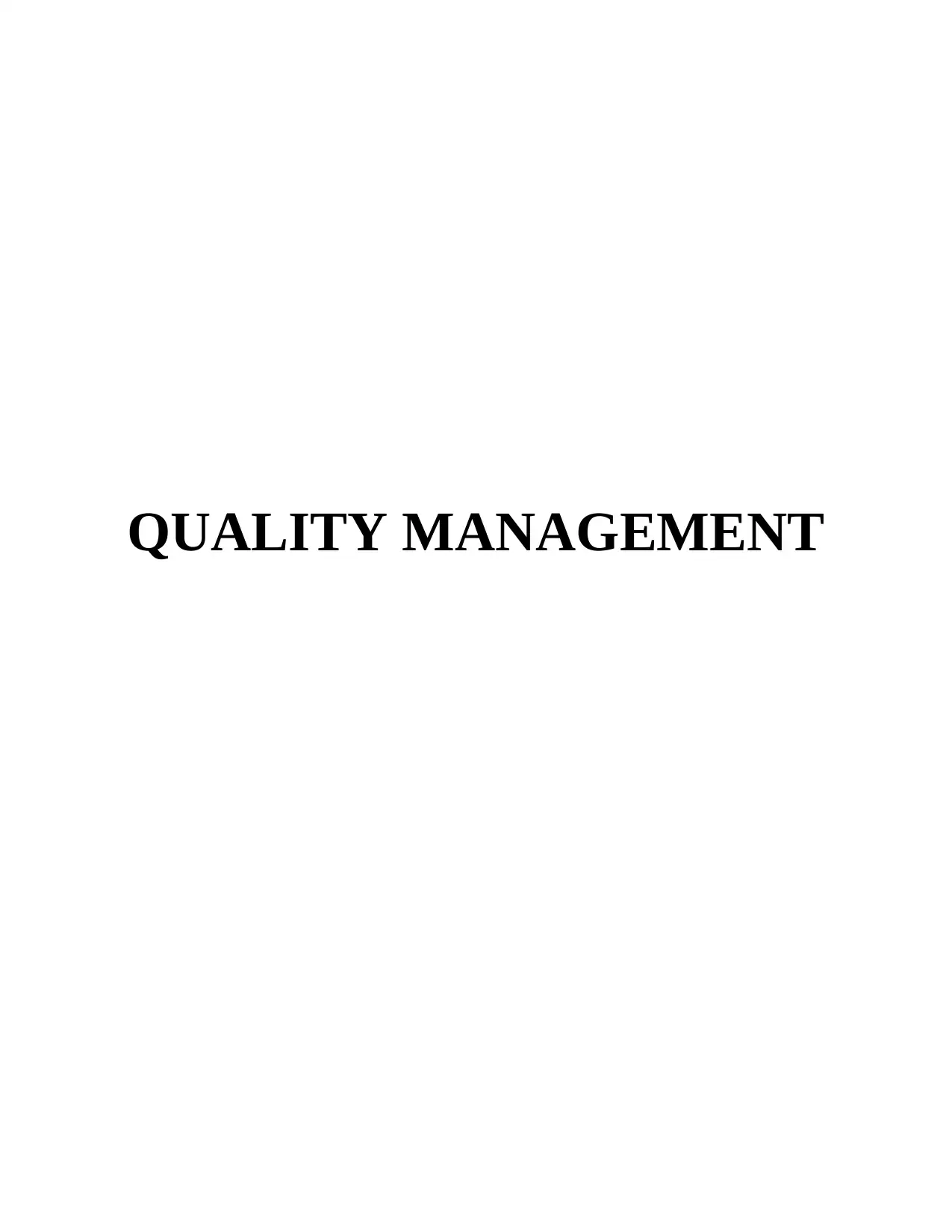
QUALITY MANAGEMENT
Paraphrase This Document
Need a fresh take? Get an instant paraphrase of this document with our AI Paraphraser
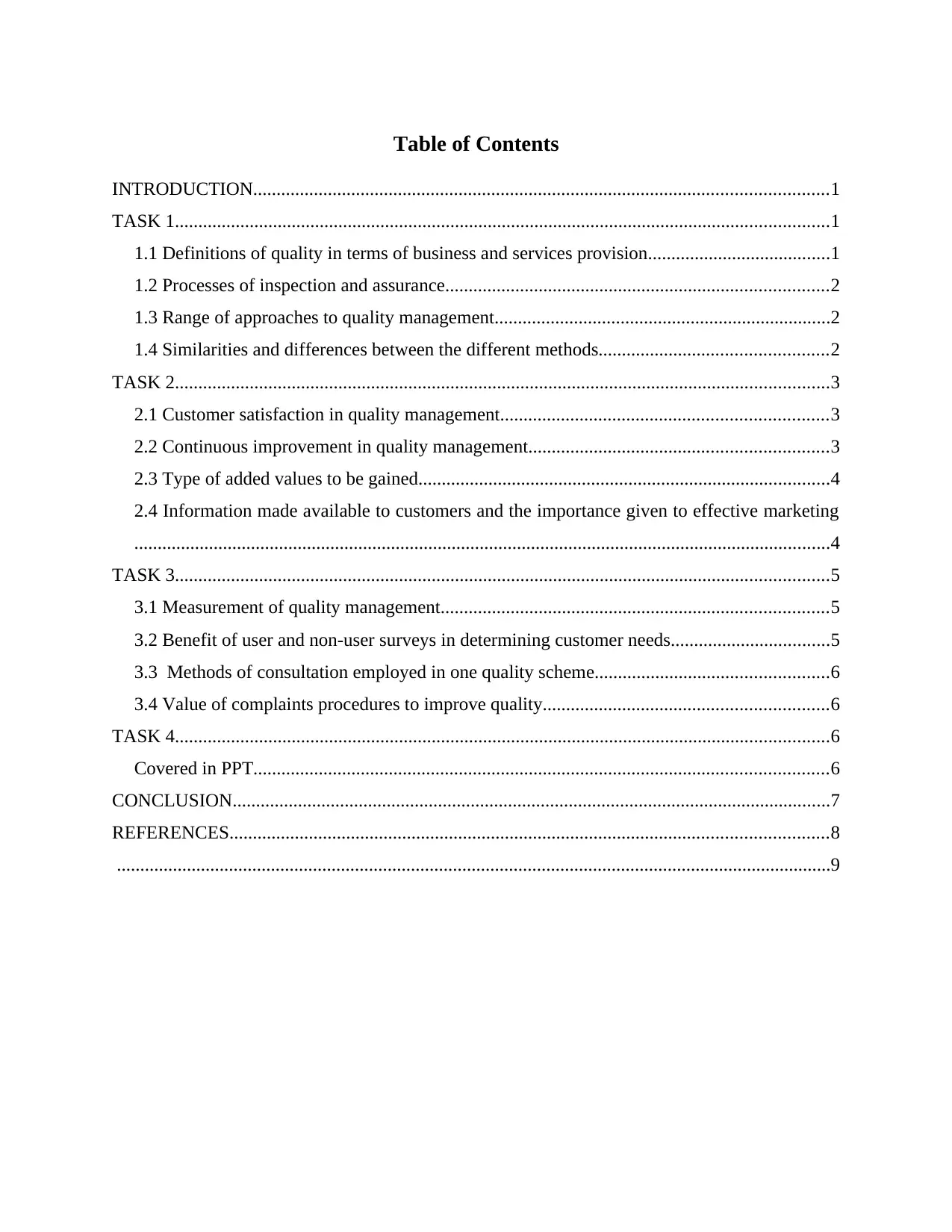
Table of Contents
INTRODUCTION...........................................................................................................................1
TASK 1............................................................................................................................................1
1.1 Definitions of quality in terms of business and services provision.......................................1
1.2 Processes of inspection and assurance..................................................................................2
1.3 Range of approaches to quality management........................................................................2
1.4 Similarities and differences between the different methods.................................................2
TASK 2............................................................................................................................................3
2.1 Customer satisfaction in quality management......................................................................3
2.2 Continuous improvement in quality management................................................................3
2.3 Type of added values to be gained........................................................................................4
2.4 Information made available to customers and the importance given to effective marketing
.....................................................................................................................................................4
TASK 3............................................................................................................................................5
3.1 Measurement of quality management...................................................................................5
3.2 Benefit of user and non-user surveys in determining customer needs..................................5
3.3 Methods of consultation employed in one quality scheme..................................................6
3.4 Value of complaints procedures to improve quality.............................................................6
TASK 4............................................................................................................................................6
Covered in PPT...........................................................................................................................6
CONCLUSION................................................................................................................................7
REFERENCES................................................................................................................................8
.........................................................................................................................................................9
INTRODUCTION...........................................................................................................................1
TASK 1............................................................................................................................................1
1.1 Definitions of quality in terms of business and services provision.......................................1
1.2 Processes of inspection and assurance..................................................................................2
1.3 Range of approaches to quality management........................................................................2
1.4 Similarities and differences between the different methods.................................................2
TASK 2............................................................................................................................................3
2.1 Customer satisfaction in quality management......................................................................3
2.2 Continuous improvement in quality management................................................................3
2.3 Type of added values to be gained........................................................................................4
2.4 Information made available to customers and the importance given to effective marketing
.....................................................................................................................................................4
TASK 3............................................................................................................................................5
3.1 Measurement of quality management...................................................................................5
3.2 Benefit of user and non-user surveys in determining customer needs..................................5
3.3 Methods of consultation employed in one quality scheme..................................................6
3.4 Value of complaints procedures to improve quality.............................................................6
TASK 4............................................................................................................................................6
Covered in PPT...........................................................................................................................6
CONCLUSION................................................................................................................................7
REFERENCES................................................................................................................................8
.........................................................................................................................................................9
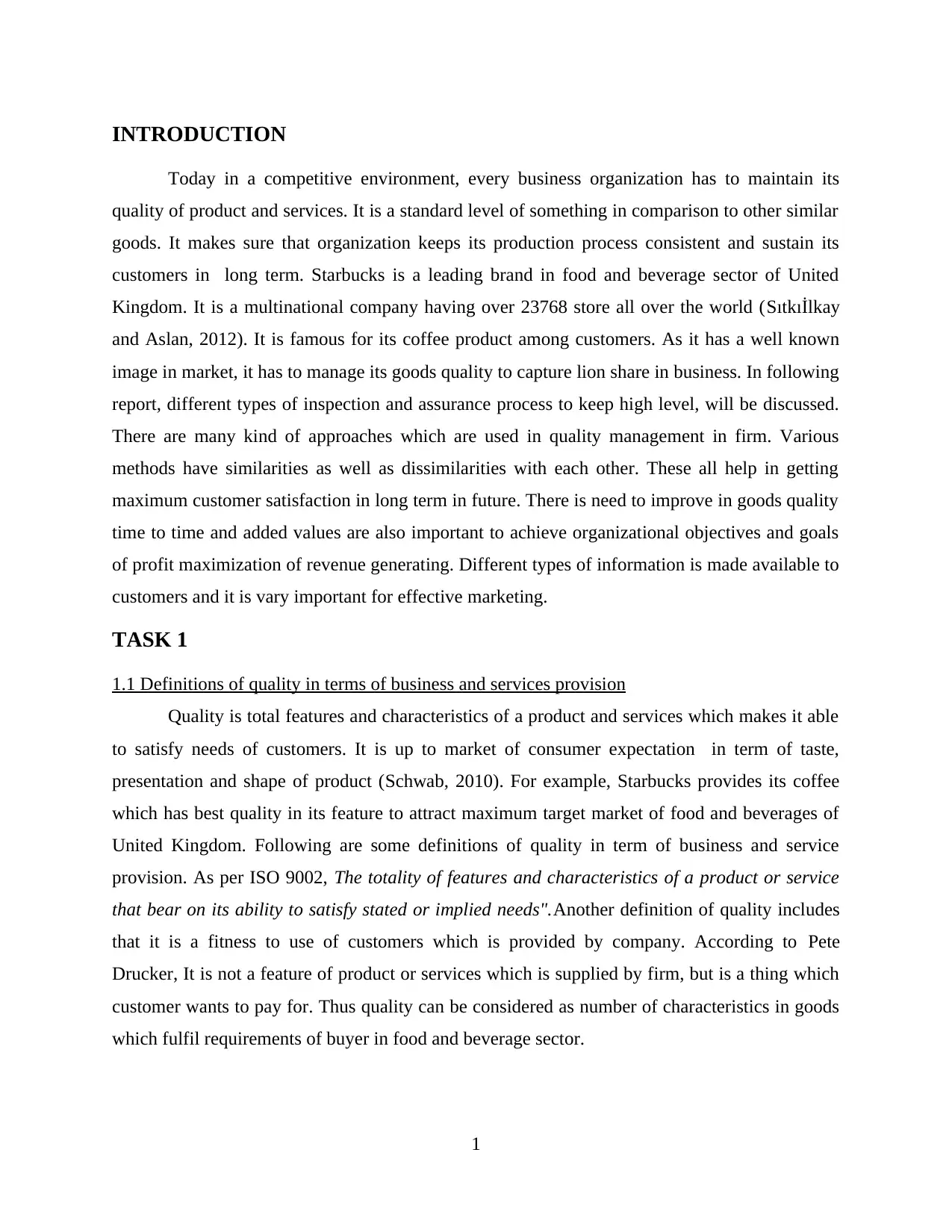
INTRODUCTION
Today in a competitive environment, every business organization has to maintain its
quality of product and services. It is a standard level of something in comparison to other similar
goods. It makes sure that organization keeps its production process consistent and sustain its
customers in long term. Starbucks is a leading brand in food and beverage sector of United
Kingdom. It is a multinational company having over 23768 store all over the world (Sıtkıİlkay
and Aslan, 2012). It is famous for its coffee product among customers. As it has a well known
image in market, it has to manage its goods quality to capture lion share in business. In following
report, different types of inspection and assurance process to keep high level, will be discussed.
There are many kind of approaches which are used in quality management in firm. Various
methods have similarities as well as dissimilarities with each other. These all help in getting
maximum customer satisfaction in long term in future. There is need to improve in goods quality
time to time and added values are also important to achieve organizational objectives and goals
of profit maximization of revenue generating. Different types of information is made available to
customers and it is vary important for effective marketing.
TASK 1
1.1 Definitions of quality in terms of business and services provision
Quality is total features and characteristics of a product and services which makes it able
to satisfy needs of customers. It is up to market of consumer expectation in term of taste,
presentation and shape of product (Schwab, 2010). For example, Starbucks provides its coffee
which has best quality in its feature to attract maximum target market of food and beverages of
United Kingdom. Following are some definitions of quality in term of business and service
provision. As per ISO 9002, The totality of features and characteristics of a product or service
that bear on its ability to satisfy stated or implied needs".Another definition of quality includes
that it is a fitness to use of customers which is provided by company. According to Pete
Drucker, It is not a feature of product or services which is supplied by firm, but is a thing which
customer wants to pay for. Thus quality can be considered as number of characteristics in goods
which fulfil requirements of buyer in food and beverage sector.
1
Today in a competitive environment, every business organization has to maintain its
quality of product and services. It is a standard level of something in comparison to other similar
goods. It makes sure that organization keeps its production process consistent and sustain its
customers in long term. Starbucks is a leading brand in food and beverage sector of United
Kingdom. It is a multinational company having over 23768 store all over the world (Sıtkıİlkay
and Aslan, 2012). It is famous for its coffee product among customers. As it has a well known
image in market, it has to manage its goods quality to capture lion share in business. In following
report, different types of inspection and assurance process to keep high level, will be discussed.
There are many kind of approaches which are used in quality management in firm. Various
methods have similarities as well as dissimilarities with each other. These all help in getting
maximum customer satisfaction in long term in future. There is need to improve in goods quality
time to time and added values are also important to achieve organizational objectives and goals
of profit maximization of revenue generating. Different types of information is made available to
customers and it is vary important for effective marketing.
TASK 1
1.1 Definitions of quality in terms of business and services provision
Quality is total features and characteristics of a product and services which makes it able
to satisfy needs of customers. It is up to market of consumer expectation in term of taste,
presentation and shape of product (Schwab, 2010). For example, Starbucks provides its coffee
which has best quality in its feature to attract maximum target market of food and beverages of
United Kingdom. Following are some definitions of quality in term of business and service
provision. As per ISO 9002, The totality of features and characteristics of a product or service
that bear on its ability to satisfy stated or implied needs".Another definition of quality includes
that it is a fitness to use of customers which is provided by company. According to Pete
Drucker, It is not a feature of product or services which is supplied by firm, but is a thing which
customer wants to pay for. Thus quality can be considered as number of characteristics in goods
which fulfil requirements of buyer in food and beverage sector.
1
⊘ This is a preview!⊘
Do you want full access?
Subscribe today to unlock all pages.

Trusted by 1+ million students worldwide
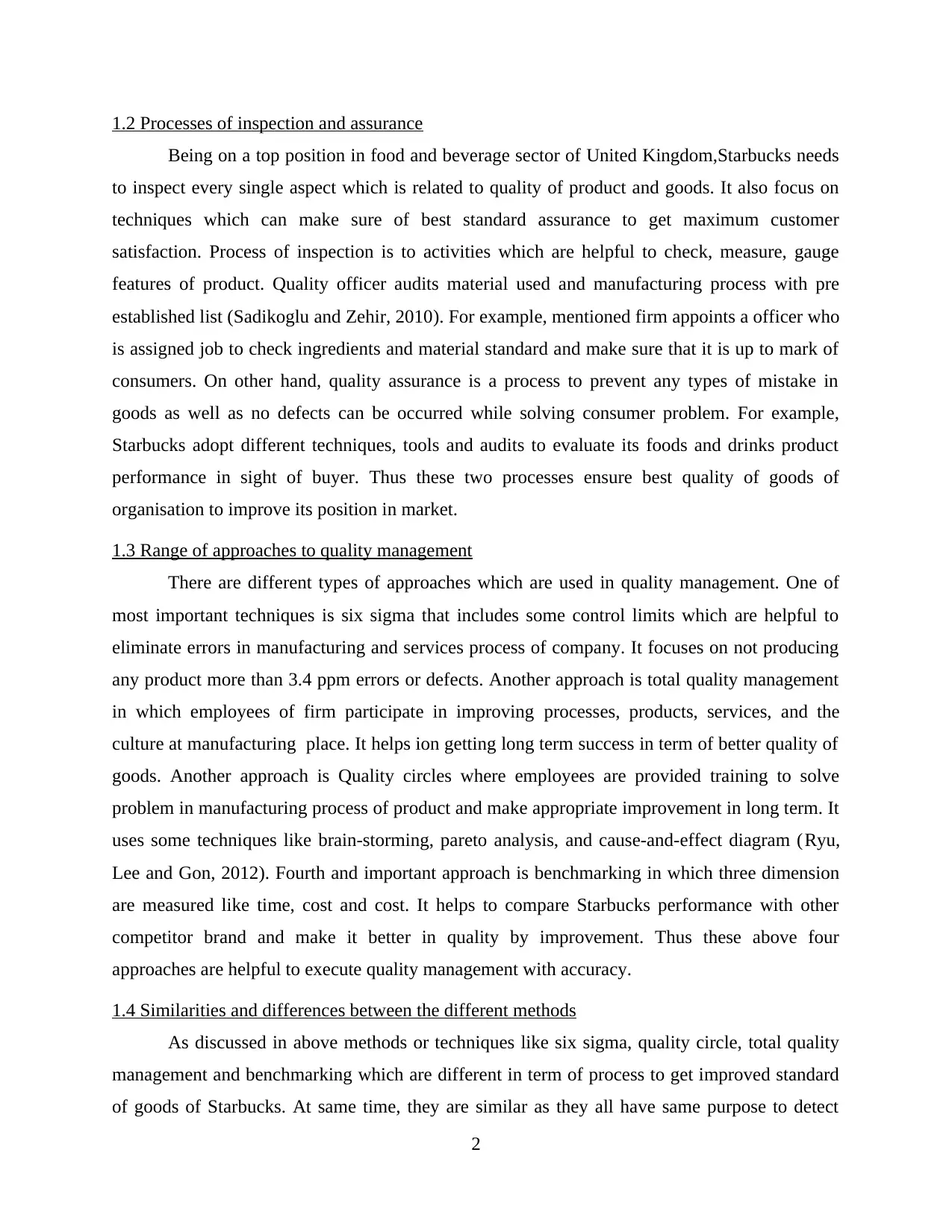
1.2 Processes of inspection and assurance
Being on a top position in food and beverage sector of United Kingdom,Starbucks needs
to inspect every single aspect which is related to quality of product and goods. It also focus on
techniques which can make sure of best standard assurance to get maximum customer
satisfaction. Process of inspection is to activities which are helpful to check, measure, gauge
features of product. Quality officer audits material used and manufacturing process with pre
established list (Sadikoglu and Zehir, 2010). For example, mentioned firm appoints a officer who
is assigned job to check ingredients and material standard and make sure that it is up to mark of
consumers. On other hand, quality assurance is a process to prevent any types of mistake in
goods as well as no defects can be occurred while solving consumer problem. For example,
Starbucks adopt different techniques, tools and audits to evaluate its foods and drinks product
performance in sight of buyer. Thus these two processes ensure best quality of goods of
organisation to improve its position in market.
1.3 Range of approaches to quality management
There are different types of approaches which are used in quality management. One of
most important techniques is six sigma that includes some control limits which are helpful to
eliminate errors in manufacturing and services process of company. It focuses on not producing
any product more than 3.4 ppm errors or defects. Another approach is total quality management
in which employees of firm participate in improving processes, products, services, and the
culture at manufacturing place. It helps ion getting long term success in term of better quality of
goods. Another approach is Quality circles where employees are provided training to solve
problem in manufacturing process of product and make appropriate improvement in long term. It
uses some techniques like brain-storming, pareto analysis, and cause-and-effect diagram (Ryu,
Lee and Gon, 2012). Fourth and important approach is benchmarking in which three dimension
are measured like time, cost and cost. It helps to compare Starbucks performance with other
competitor brand and make it better in quality by improvement. Thus these above four
approaches are helpful to execute quality management with accuracy.
1.4 Similarities and differences between the different methods
As discussed in above methods or techniques like six sigma, quality circle, total quality
management and benchmarking which are different in term of process to get improved standard
of goods of Starbucks. At same time, they are similar as they all have same purpose to detect
2
Being on a top position in food and beverage sector of United Kingdom,Starbucks needs
to inspect every single aspect which is related to quality of product and goods. It also focus on
techniques which can make sure of best standard assurance to get maximum customer
satisfaction. Process of inspection is to activities which are helpful to check, measure, gauge
features of product. Quality officer audits material used and manufacturing process with pre
established list (Sadikoglu and Zehir, 2010). For example, mentioned firm appoints a officer who
is assigned job to check ingredients and material standard and make sure that it is up to mark of
consumers. On other hand, quality assurance is a process to prevent any types of mistake in
goods as well as no defects can be occurred while solving consumer problem. For example,
Starbucks adopt different techniques, tools and audits to evaluate its foods and drinks product
performance in sight of buyer. Thus these two processes ensure best quality of goods of
organisation to improve its position in market.
1.3 Range of approaches to quality management
There are different types of approaches which are used in quality management. One of
most important techniques is six sigma that includes some control limits which are helpful to
eliminate errors in manufacturing and services process of company. It focuses on not producing
any product more than 3.4 ppm errors or defects. Another approach is total quality management
in which employees of firm participate in improving processes, products, services, and the
culture at manufacturing place. It helps ion getting long term success in term of better quality of
goods. Another approach is Quality circles where employees are provided training to solve
problem in manufacturing process of product and make appropriate improvement in long term. It
uses some techniques like brain-storming, pareto analysis, and cause-and-effect diagram (Ryu,
Lee and Gon, 2012). Fourth and important approach is benchmarking in which three dimension
are measured like time, cost and cost. It helps to compare Starbucks performance with other
competitor brand and make it better in quality by improvement. Thus these above four
approaches are helpful to execute quality management with accuracy.
1.4 Similarities and differences between the different methods
As discussed in above methods or techniques like six sigma, quality circle, total quality
management and benchmarking which are different in term of process to get improved standard
of goods of Starbucks. At same time, they are similar as they all have same purpose to detect
2
Paraphrase This Document
Need a fresh take? Get an instant paraphrase of this document with our AI Paraphraser
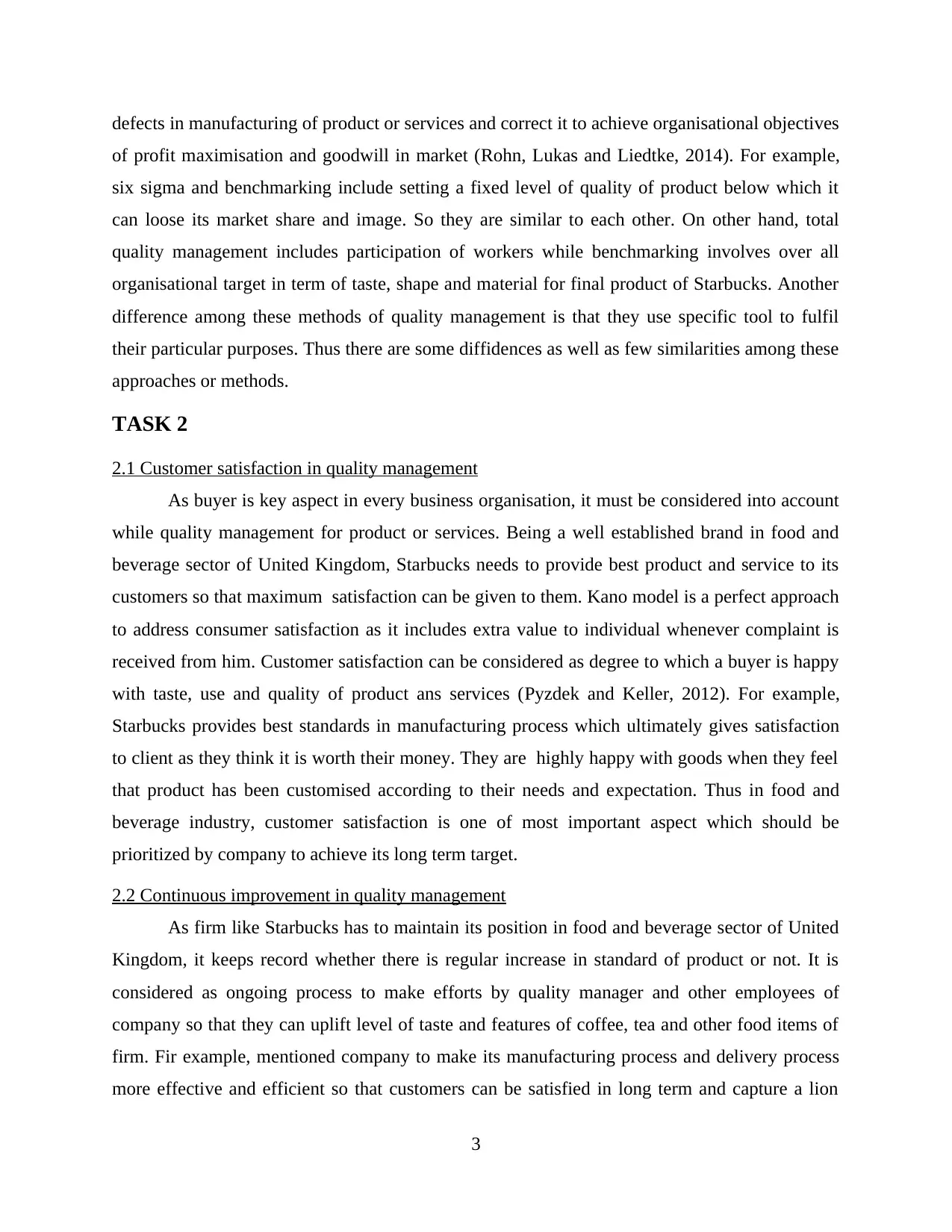
defects in manufacturing of product or services and correct it to achieve organisational objectives
of profit maximisation and goodwill in market (Rohn, Lukas and Liedtke, 2014). For example,
six sigma and benchmarking include setting a fixed level of quality of product below which it
can loose its market share and image. So they are similar to each other. On other hand, total
quality management includes participation of workers while benchmarking involves over all
organisational target in term of taste, shape and material for final product of Starbucks. Another
difference among these methods of quality management is that they use specific tool to fulfil
their particular purposes. Thus there are some diffidences as well as few similarities among these
approaches or methods.
TASK 2
2.1 Customer satisfaction in quality management
As buyer is key aspect in every business organisation, it must be considered into account
while quality management for product or services. Being a well established brand in food and
beverage sector of United Kingdom, Starbucks needs to provide best product and service to its
customers so that maximum satisfaction can be given to them. Kano model is a perfect approach
to address consumer satisfaction as it includes extra value to individual whenever complaint is
received from him. Customer satisfaction can be considered as degree to which a buyer is happy
with taste, use and quality of product ans services (Pyzdek and Keller, 2012). For example,
Starbucks provides best standards in manufacturing process which ultimately gives satisfaction
to client as they think it is worth their money. They are highly happy with goods when they feel
that product has been customised according to their needs and expectation. Thus in food and
beverage industry, customer satisfaction is one of most important aspect which should be
prioritized by company to achieve its long term target.
2.2 Continuous improvement in quality management
As firm like Starbucks has to maintain its position in food and beverage sector of United
Kingdom, it keeps record whether there is regular increase in standard of product or not. It is
considered as ongoing process to make efforts by quality manager and other employees of
company so that they can uplift level of taste and features of coffee, tea and other food items of
firm. Fir example, mentioned company to make its manufacturing process and delivery process
more effective and efficient so that customers can be satisfied in long term and capture a lion
3
of profit maximisation and goodwill in market (Rohn, Lukas and Liedtke, 2014). For example,
six sigma and benchmarking include setting a fixed level of quality of product below which it
can loose its market share and image. So they are similar to each other. On other hand, total
quality management includes participation of workers while benchmarking involves over all
organisational target in term of taste, shape and material for final product of Starbucks. Another
difference among these methods of quality management is that they use specific tool to fulfil
their particular purposes. Thus there are some diffidences as well as few similarities among these
approaches or methods.
TASK 2
2.1 Customer satisfaction in quality management
As buyer is key aspect in every business organisation, it must be considered into account
while quality management for product or services. Being a well established brand in food and
beverage sector of United Kingdom, Starbucks needs to provide best product and service to its
customers so that maximum satisfaction can be given to them. Kano model is a perfect approach
to address consumer satisfaction as it includes extra value to individual whenever complaint is
received from him. Customer satisfaction can be considered as degree to which a buyer is happy
with taste, use and quality of product ans services (Pyzdek and Keller, 2012). For example,
Starbucks provides best standards in manufacturing process which ultimately gives satisfaction
to client as they think it is worth their money. They are highly happy with goods when they feel
that product has been customised according to their needs and expectation. Thus in food and
beverage industry, customer satisfaction is one of most important aspect which should be
prioritized by company to achieve its long term target.
2.2 Continuous improvement in quality management
As firm like Starbucks has to maintain its position in food and beverage sector of United
Kingdom, it keeps record whether there is regular increase in standard of product or not. It is
considered as ongoing process to make efforts by quality manager and other employees of
company so that they can uplift level of taste and features of coffee, tea and other food items of
firm. Fir example, mentioned company to make its manufacturing process and delivery process
more effective and efficient so that customers can be satisfied in long term and capture a lion
3
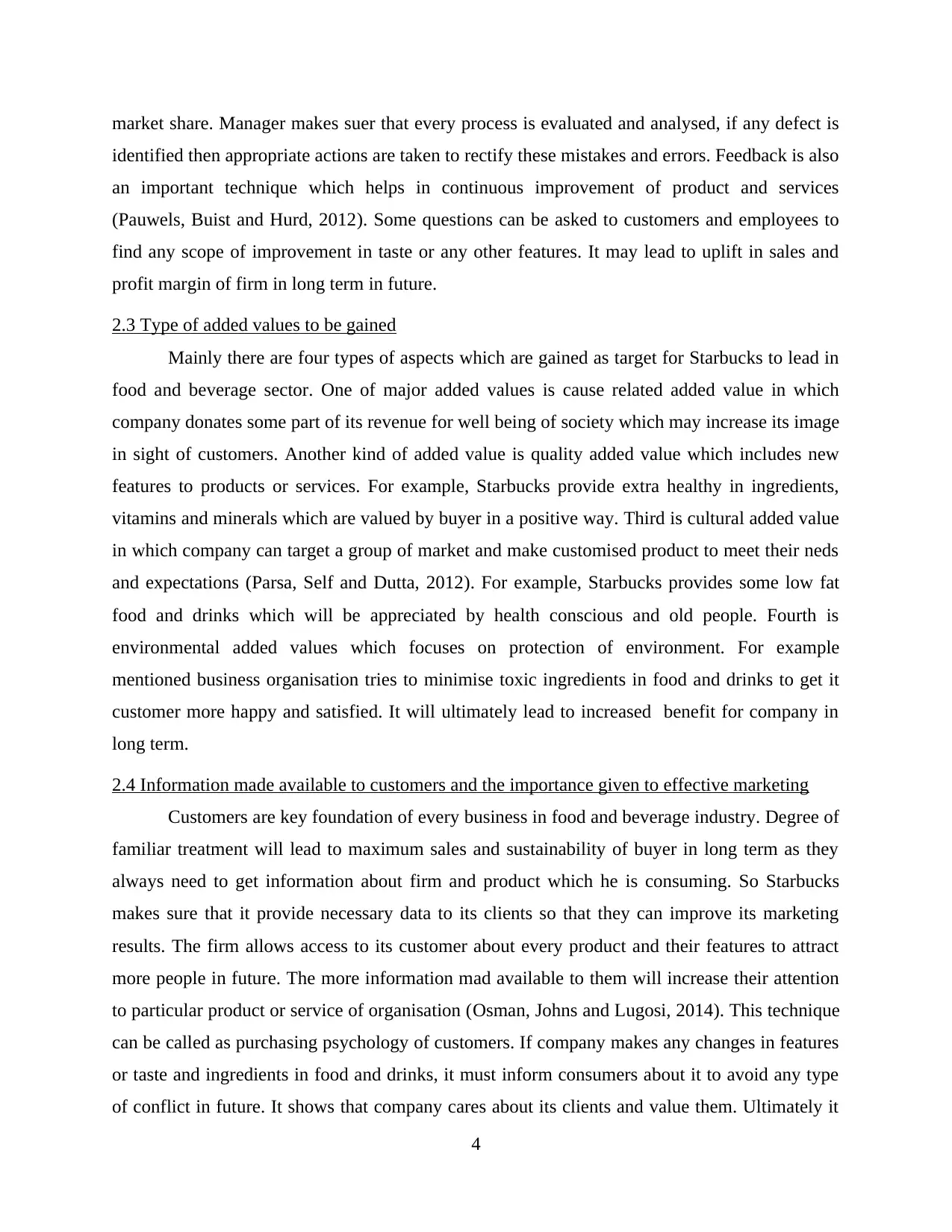
market share. Manager makes suer that every process is evaluated and analysed, if any defect is
identified then appropriate actions are taken to rectify these mistakes and errors. Feedback is also
an important technique which helps in continuous improvement of product and services
(Pauwels, Buist and Hurd, 2012). Some questions can be asked to customers and employees to
find any scope of improvement in taste or any other features. It may lead to uplift in sales and
profit margin of firm in long term in future.
2.3 Type of added values to be gained
Mainly there are four types of aspects which are gained as target for Starbucks to lead in
food and beverage sector. One of major added values is cause related added value in which
company donates some part of its revenue for well being of society which may increase its image
in sight of customers. Another kind of added value is quality added value which includes new
features to products or services. For example, Starbucks provide extra healthy in ingredients,
vitamins and minerals which are valued by buyer in a positive way. Third is cultural added value
in which company can target a group of market and make customised product to meet their neds
and expectations (Parsa, Self and Dutta, 2012). For example, Starbucks provides some low fat
food and drinks which will be appreciated by health conscious and old people. Fourth is
environmental added values which focuses on protection of environment. For example
mentioned business organisation tries to minimise toxic ingredients in food and drinks to get it
customer more happy and satisfied. It will ultimately lead to increased benefit for company in
long term.
2.4 Information made available to customers and the importance given to effective marketing
Customers are key foundation of every business in food and beverage industry. Degree of
familiar treatment will lead to maximum sales and sustainability of buyer in long term as they
always need to get information about firm and product which he is consuming. So Starbucks
makes sure that it provide necessary data to its clients so that they can improve its marketing
results. The firm allows access to its customer about every product and their features to attract
more people in future. The more information mad available to them will increase their attention
to particular product or service of organisation (Osman, Johns and Lugosi, 2014). This technique
can be called as purchasing psychology of customers. If company makes any changes in features
or taste and ingredients in food and drinks, it must inform consumers about it to avoid any type
of conflict in future. It shows that company cares about its clients and value them. Ultimately it
4
identified then appropriate actions are taken to rectify these mistakes and errors. Feedback is also
an important technique which helps in continuous improvement of product and services
(Pauwels, Buist and Hurd, 2012). Some questions can be asked to customers and employees to
find any scope of improvement in taste or any other features. It may lead to uplift in sales and
profit margin of firm in long term in future.
2.3 Type of added values to be gained
Mainly there are four types of aspects which are gained as target for Starbucks to lead in
food and beverage sector. One of major added values is cause related added value in which
company donates some part of its revenue for well being of society which may increase its image
in sight of customers. Another kind of added value is quality added value which includes new
features to products or services. For example, Starbucks provide extra healthy in ingredients,
vitamins and minerals which are valued by buyer in a positive way. Third is cultural added value
in which company can target a group of market and make customised product to meet their neds
and expectations (Parsa, Self and Dutta, 2012). For example, Starbucks provides some low fat
food and drinks which will be appreciated by health conscious and old people. Fourth is
environmental added values which focuses on protection of environment. For example
mentioned business organisation tries to minimise toxic ingredients in food and drinks to get it
customer more happy and satisfied. It will ultimately lead to increased benefit for company in
long term.
2.4 Information made available to customers and the importance given to effective marketing
Customers are key foundation of every business in food and beverage industry. Degree of
familiar treatment will lead to maximum sales and sustainability of buyer in long term as they
always need to get information about firm and product which he is consuming. So Starbucks
makes sure that it provide necessary data to its clients so that they can improve its marketing
results. The firm allows access to its customer about every product and their features to attract
more people in future. The more information mad available to them will increase their attention
to particular product or service of organisation (Osman, Johns and Lugosi, 2014). This technique
can be called as purchasing psychology of customers. If company makes any changes in features
or taste and ingredients in food and drinks, it must inform consumers about it to avoid any type
of conflict in future. It shows that company cares about its clients and value them. Ultimately it
4
⊘ This is a preview!⊘
Do you want full access?
Subscribe today to unlock all pages.

Trusted by 1+ million students worldwide
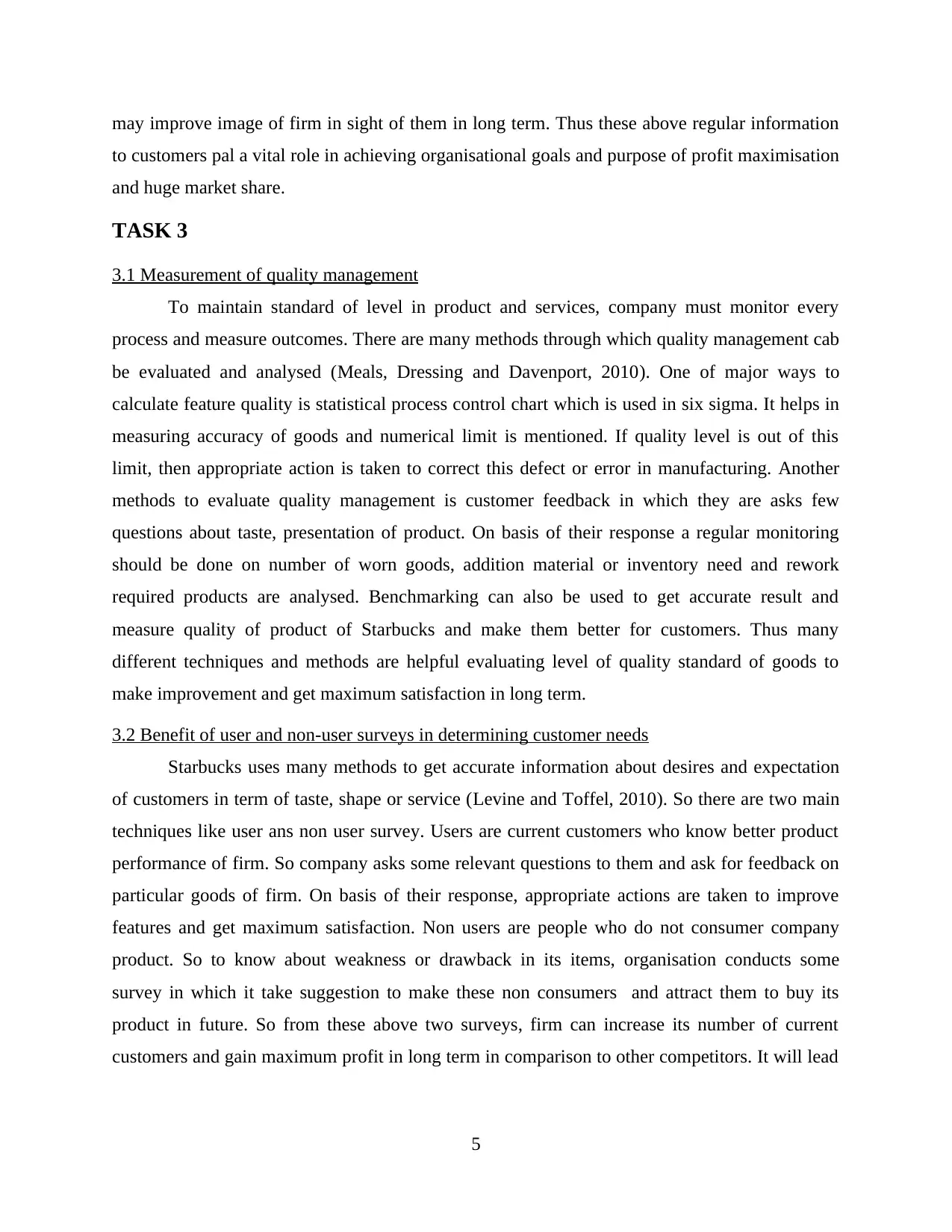
may improve image of firm in sight of them in long term. Thus these above regular information
to customers pal a vital role in achieving organisational goals and purpose of profit maximisation
and huge market share.
TASK 3
3.1 Measurement of quality management
To maintain standard of level in product and services, company must monitor every
process and measure outcomes. There are many methods through which quality management cab
be evaluated and analysed (Meals, Dressing and Davenport, 2010). One of major ways to
calculate feature quality is statistical process control chart which is used in six sigma. It helps in
measuring accuracy of goods and numerical limit is mentioned. If quality level is out of this
limit, then appropriate action is taken to correct this defect or error in manufacturing. Another
methods to evaluate quality management is customer feedback in which they are asks few
questions about taste, presentation of product. On basis of their response a regular monitoring
should be done on number of worn goods, addition material or inventory need and rework
required products are analysed. Benchmarking can also be used to get accurate result and
measure quality of product of Starbucks and make them better for customers. Thus many
different techniques and methods are helpful evaluating level of quality standard of goods to
make improvement and get maximum satisfaction in long term.
3.2 Benefit of user and non-user surveys in determining customer needs
Starbucks uses many methods to get accurate information about desires and expectation
of customers in term of taste, shape or service (Levine and Toffel, 2010). So there are two main
techniques like user ans non user survey. Users are current customers who know better product
performance of firm. So company asks some relevant questions to them and ask for feedback on
particular goods of firm. On basis of their response, appropriate actions are taken to improve
features and get maximum satisfaction. Non users are people who do not consumer company
product. So to know about weakness or drawback in its items, organisation conducts some
survey in which it take suggestion to make these non consumers and attract them to buy its
product in future. So from these above two surveys, firm can increase its number of current
customers and gain maximum profit in long term in comparison to other competitors. It will lead
5
to customers pal a vital role in achieving organisational goals and purpose of profit maximisation
and huge market share.
TASK 3
3.1 Measurement of quality management
To maintain standard of level in product and services, company must monitor every
process and measure outcomes. There are many methods through which quality management cab
be evaluated and analysed (Meals, Dressing and Davenport, 2010). One of major ways to
calculate feature quality is statistical process control chart which is used in six sigma. It helps in
measuring accuracy of goods and numerical limit is mentioned. If quality level is out of this
limit, then appropriate action is taken to correct this defect or error in manufacturing. Another
methods to evaluate quality management is customer feedback in which they are asks few
questions about taste, presentation of product. On basis of their response a regular monitoring
should be done on number of worn goods, addition material or inventory need and rework
required products are analysed. Benchmarking can also be used to get accurate result and
measure quality of product of Starbucks and make them better for customers. Thus many
different techniques and methods are helpful evaluating level of quality standard of goods to
make improvement and get maximum satisfaction in long term.
3.2 Benefit of user and non-user surveys in determining customer needs
Starbucks uses many methods to get accurate information about desires and expectation
of customers in term of taste, shape or service (Levine and Toffel, 2010). So there are two main
techniques like user ans non user survey. Users are current customers who know better product
performance of firm. So company asks some relevant questions to them and ask for feedback on
particular goods of firm. On basis of their response, appropriate actions are taken to improve
features and get maximum satisfaction. Non users are people who do not consumer company
product. So to know about weakness or drawback in its items, organisation conducts some
survey in which it take suggestion to make these non consumers and attract them to buy its
product in future. So from these above two surveys, firm can increase its number of current
customers and gain maximum profit in long term in comparison to other competitors. It will lead
5
Paraphrase This Document
Need a fresh take? Get an instant paraphrase of this document with our AI Paraphraser
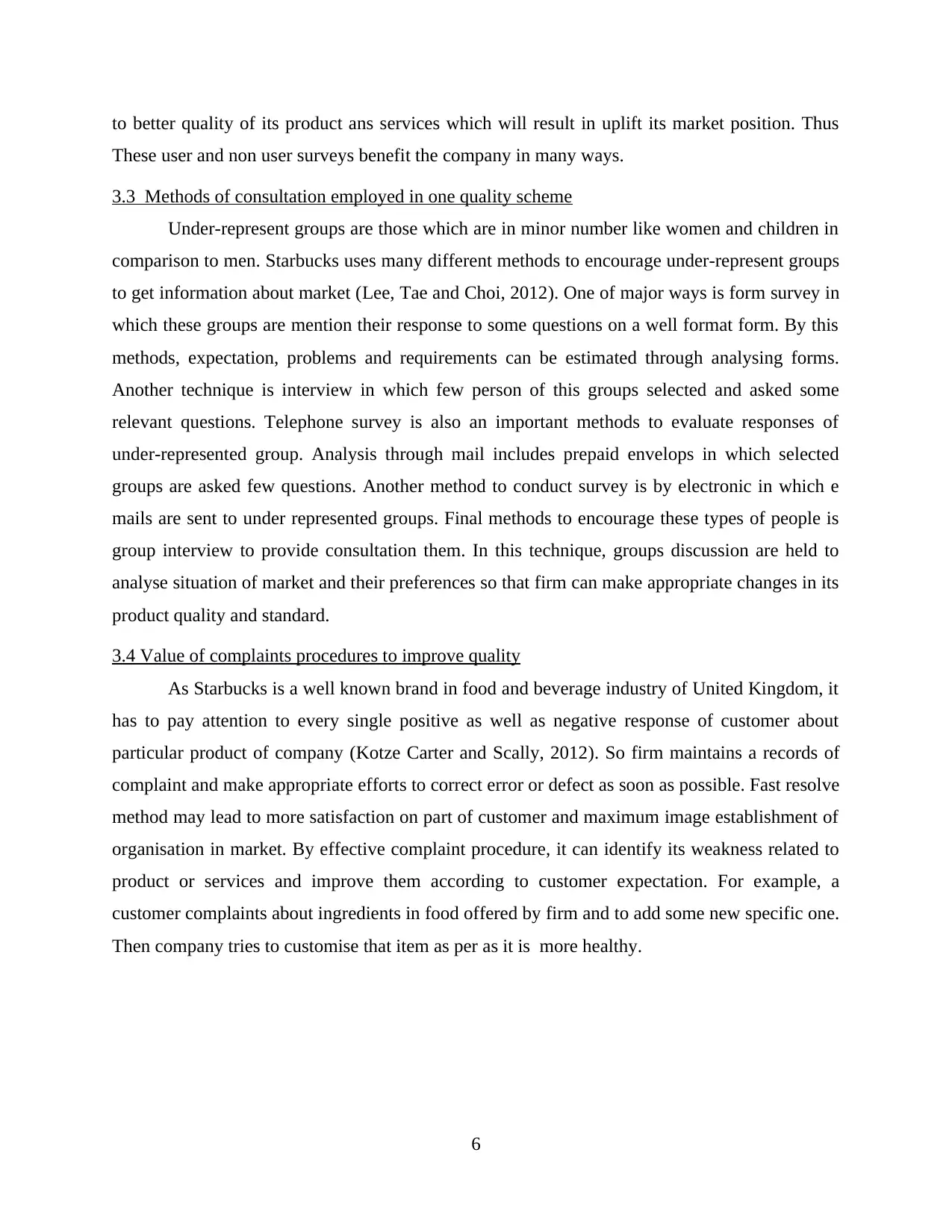
to better quality of its product ans services which will result in uplift its market position. Thus
These user and non user surveys benefit the company in many ways.
3.3 Methods of consultation employed in one quality scheme
Under-represent groups are those which are in minor number like women and children in
comparison to men. Starbucks uses many different methods to encourage under-represent groups
to get information about market (Lee, Tae and Choi, 2012). One of major ways is form survey in
which these groups are mention their response to some questions on a well format form. By this
methods, expectation, problems and requirements can be estimated through analysing forms.
Another technique is interview in which few person of this groups selected and asked some
relevant questions. Telephone survey is also an important methods to evaluate responses of
under-represented group. Analysis through mail includes prepaid envelops in which selected
groups are asked few questions. Another method to conduct survey is by electronic in which e
mails are sent to under represented groups. Final methods to encourage these types of people is
group interview to provide consultation them. In this technique, groups discussion are held to
analyse situation of market and their preferences so that firm can make appropriate changes in its
product quality and standard.
3.4 Value of complaints procedures to improve quality
As Starbucks is a well known brand in food and beverage industry of United Kingdom, it
has to pay attention to every single positive as well as negative response of customer about
particular product of company (Kotze Carter and Scally, 2012). So firm maintains a records of
complaint and make appropriate efforts to correct error or defect as soon as possible. Fast resolve
method may lead to more satisfaction on part of customer and maximum image establishment of
organisation in market. By effective complaint procedure, it can identify its weakness related to
product or services and improve them according to customer expectation. For example, a
customer complaints about ingredients in food offered by firm and to add some new specific one.
Then company tries to customise that item as per as it is more healthy.
6
These user and non user surveys benefit the company in many ways.
3.3 Methods of consultation employed in one quality scheme
Under-represent groups are those which are in minor number like women and children in
comparison to men. Starbucks uses many different methods to encourage under-represent groups
to get information about market (Lee, Tae and Choi, 2012). One of major ways is form survey in
which these groups are mention their response to some questions on a well format form. By this
methods, expectation, problems and requirements can be estimated through analysing forms.
Another technique is interview in which few person of this groups selected and asked some
relevant questions. Telephone survey is also an important methods to evaluate responses of
under-represented group. Analysis through mail includes prepaid envelops in which selected
groups are asked few questions. Another method to conduct survey is by electronic in which e
mails are sent to under represented groups. Final methods to encourage these types of people is
group interview to provide consultation them. In this technique, groups discussion are held to
analyse situation of market and their preferences so that firm can make appropriate changes in its
product quality and standard.
3.4 Value of complaints procedures to improve quality
As Starbucks is a well known brand in food and beverage industry of United Kingdom, it
has to pay attention to every single positive as well as negative response of customer about
particular product of company (Kotze Carter and Scally, 2012). So firm maintains a records of
complaint and make appropriate efforts to correct error or defect as soon as possible. Fast resolve
method may lead to more satisfaction on part of customer and maximum image establishment of
organisation in market. By effective complaint procedure, it can identify its weakness related to
product or services and improve them according to customer expectation. For example, a
customer complaints about ingredients in food offered by firm and to add some new specific one.
Then company tries to customise that item as per as it is more healthy.
6
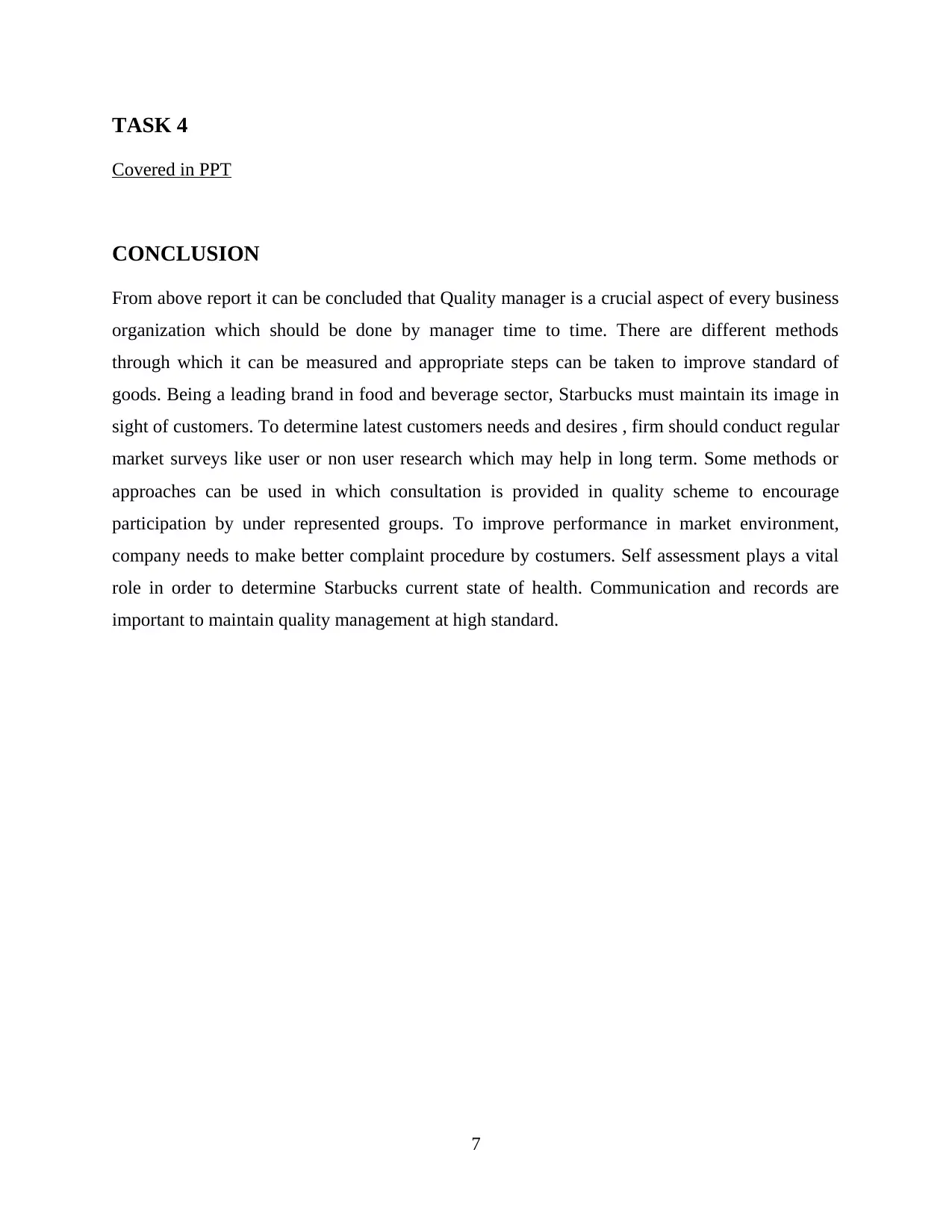
TASK 4
Covered in PPT
CONCLUSION
From above report it can be concluded that Quality manager is a crucial aspect of every business
organization which should be done by manager time to time. There are different methods
through which it can be measured and appropriate steps can be taken to improve standard of
goods. Being a leading brand in food and beverage sector, Starbucks must maintain its image in
sight of customers. To determine latest customers needs and desires , firm should conduct regular
market surveys like user or non user research which may help in long term. Some methods or
approaches can be used in which consultation is provided in quality scheme to encourage
participation by under represented groups. To improve performance in market environment,
company needs to make better complaint procedure by costumers. Self assessment plays a vital
role in order to determine Starbucks current state of health. Communication and records are
important to maintain quality management at high standard.
7
Covered in PPT
CONCLUSION
From above report it can be concluded that Quality manager is a crucial aspect of every business
organization which should be done by manager time to time. There are different methods
through which it can be measured and appropriate steps can be taken to improve standard of
goods. Being a leading brand in food and beverage sector, Starbucks must maintain its image in
sight of customers. To determine latest customers needs and desires , firm should conduct regular
market surveys like user or non user research which may help in long term. Some methods or
approaches can be used in which consultation is provided in quality scheme to encourage
participation by under represented groups. To improve performance in market environment,
company needs to make better complaint procedure by costumers. Self assessment plays a vital
role in order to determine Starbucks current state of health. Communication and records are
important to maintain quality management at high standard.
7
⊘ This is a preview!⊘
Do you want full access?
Subscribe today to unlock all pages.

Trusted by 1+ million students worldwide
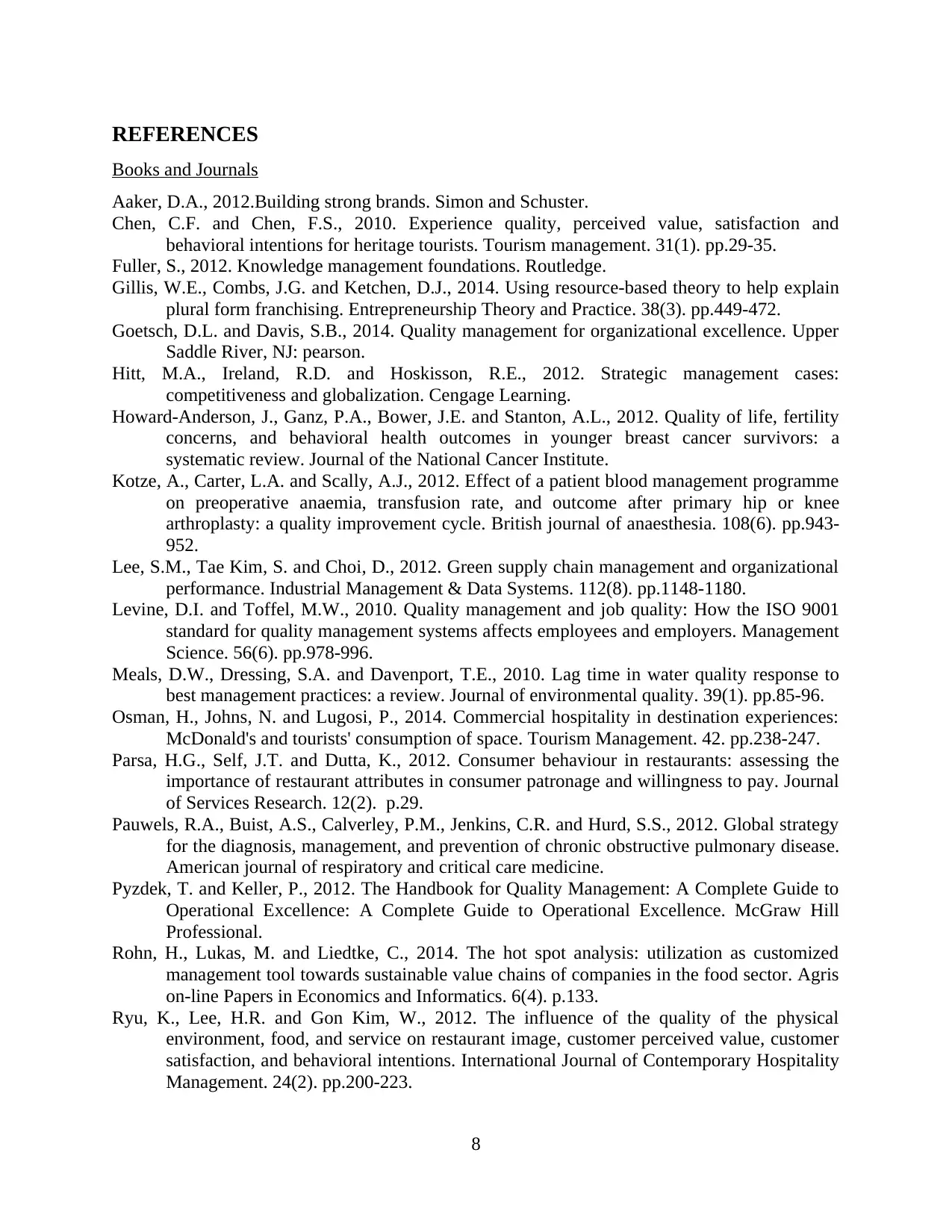
REFERENCES
Books and Journals
Aaker, D.A., 2012.Building strong brands. Simon and Schuster.
Chen, C.F. and Chen, F.S., 2010. Experience quality, perceived value, satisfaction and
behavioral intentions for heritage tourists. Tourism management. 31(1). pp.29-35.
Fuller, S., 2012. Knowledge management foundations. Routledge.
Gillis, W.E., Combs, J.G. and Ketchen, D.J., 2014. Using resource‐based theory to help explain
plural form franchising. Entrepreneurship Theory and Practice. 38(3). pp.449-472.
Goetsch, D.L. and Davis, S.B., 2014. Quality management for organizational excellence. Upper
Saddle River, NJ: pearson.
Hitt, M.A., Ireland, R.D. and Hoskisson, R.E., 2012. Strategic management cases:
competitiveness and globalization. Cengage Learning.
Howard-Anderson, J., Ganz, P.A., Bower, J.E. and Stanton, A.L., 2012. Quality of life, fertility
concerns, and behavioral health outcomes in younger breast cancer survivors: a
systematic review. Journal of the National Cancer Institute.
Kotze, A., Carter, L.A. and Scally, A.J., 2012. Effect of a patient blood management programme
on preoperative anaemia, transfusion rate, and outcome after primary hip or knee
arthroplasty: a quality improvement cycle. British journal of anaesthesia. 108(6). pp.943-
952.
Lee, S.M., Tae Kim, S. and Choi, D., 2012. Green supply chain management and organizational
performance. Industrial Management & Data Systems. 112(8). pp.1148-1180.
Levine, D.I. and Toffel, M.W., 2010. Quality management and job quality: How the ISO 9001
standard for quality management systems affects employees and employers. Management
Science. 56(6). pp.978-996.
Meals, D.W., Dressing, S.A. and Davenport, T.E., 2010. Lag time in water quality response to
best management practices: a review. Journal of environmental quality. 39(1). pp.85-96.
Osman, H., Johns, N. and Lugosi, P., 2014. Commercial hospitality in destination experiences:
McDonald's and tourists' consumption of space. Tourism Management. 42. pp.238-247.
Parsa, H.G., Self, J.T. and Dutta, K., 2012. Consumer behaviour in restaurants: assessing the
importance of restaurant attributes in consumer patronage and willingness to pay. Journal
of Services Research. 12(2). p.29.
Pauwels, R.A., Buist, A.S., Calverley, P.M., Jenkins, C.R. and Hurd, S.S., 2012. Global strategy
for the diagnosis, management, and prevention of chronic obstructive pulmonary disease.
American journal of respiratory and critical care medicine.
Pyzdek, T. and Keller, P., 2012. The Handbook for Quality Management: A Complete Guide to
Operational Excellence: A Complete Guide to Operational Excellence. McGraw Hill
Professional.
Rohn, H., Lukas, M. and Liedtke, C., 2014. The hot spot analysis: utilization as customized
management tool towards sustainable value chains of companies in the food sector. Agris
on-line Papers in Economics and Informatics. 6(4). p.133.
Ryu, K., Lee, H.R. and Gon Kim, W., 2012. The influence of the quality of the physical
environment, food, and service on restaurant image, customer perceived value, customer
satisfaction, and behavioral intentions. International Journal of Contemporary Hospitality
Management. 24(2). pp.200-223.
8
Books and Journals
Aaker, D.A., 2012.Building strong brands. Simon and Schuster.
Chen, C.F. and Chen, F.S., 2010. Experience quality, perceived value, satisfaction and
behavioral intentions for heritage tourists. Tourism management. 31(1). pp.29-35.
Fuller, S., 2012. Knowledge management foundations. Routledge.
Gillis, W.E., Combs, J.G. and Ketchen, D.J., 2014. Using resource‐based theory to help explain
plural form franchising. Entrepreneurship Theory and Practice. 38(3). pp.449-472.
Goetsch, D.L. and Davis, S.B., 2014. Quality management for organizational excellence. Upper
Saddle River, NJ: pearson.
Hitt, M.A., Ireland, R.D. and Hoskisson, R.E., 2012. Strategic management cases:
competitiveness and globalization. Cengage Learning.
Howard-Anderson, J., Ganz, P.A., Bower, J.E. and Stanton, A.L., 2012. Quality of life, fertility
concerns, and behavioral health outcomes in younger breast cancer survivors: a
systematic review. Journal of the National Cancer Institute.
Kotze, A., Carter, L.A. and Scally, A.J., 2012. Effect of a patient blood management programme
on preoperative anaemia, transfusion rate, and outcome after primary hip or knee
arthroplasty: a quality improvement cycle. British journal of anaesthesia. 108(6). pp.943-
952.
Lee, S.M., Tae Kim, S. and Choi, D., 2012. Green supply chain management and organizational
performance. Industrial Management & Data Systems. 112(8). pp.1148-1180.
Levine, D.I. and Toffel, M.W., 2010. Quality management and job quality: How the ISO 9001
standard for quality management systems affects employees and employers. Management
Science. 56(6). pp.978-996.
Meals, D.W., Dressing, S.A. and Davenport, T.E., 2010. Lag time in water quality response to
best management practices: a review. Journal of environmental quality. 39(1). pp.85-96.
Osman, H., Johns, N. and Lugosi, P., 2014. Commercial hospitality in destination experiences:
McDonald's and tourists' consumption of space. Tourism Management. 42. pp.238-247.
Parsa, H.G., Self, J.T. and Dutta, K., 2012. Consumer behaviour in restaurants: assessing the
importance of restaurant attributes in consumer patronage and willingness to pay. Journal
of Services Research. 12(2). p.29.
Pauwels, R.A., Buist, A.S., Calverley, P.M., Jenkins, C.R. and Hurd, S.S., 2012. Global strategy
for the diagnosis, management, and prevention of chronic obstructive pulmonary disease.
American journal of respiratory and critical care medicine.
Pyzdek, T. and Keller, P., 2012. The Handbook for Quality Management: A Complete Guide to
Operational Excellence: A Complete Guide to Operational Excellence. McGraw Hill
Professional.
Rohn, H., Lukas, M. and Liedtke, C., 2014. The hot spot analysis: utilization as customized
management tool towards sustainable value chains of companies in the food sector. Agris
on-line Papers in Economics and Informatics. 6(4). p.133.
Ryu, K., Lee, H.R. and Gon Kim, W., 2012. The influence of the quality of the physical
environment, food, and service on restaurant image, customer perceived value, customer
satisfaction, and behavioral intentions. International Journal of Contemporary Hospitality
Management. 24(2). pp.200-223.
8
Paraphrase This Document
Need a fresh take? Get an instant paraphrase of this document with our AI Paraphraser
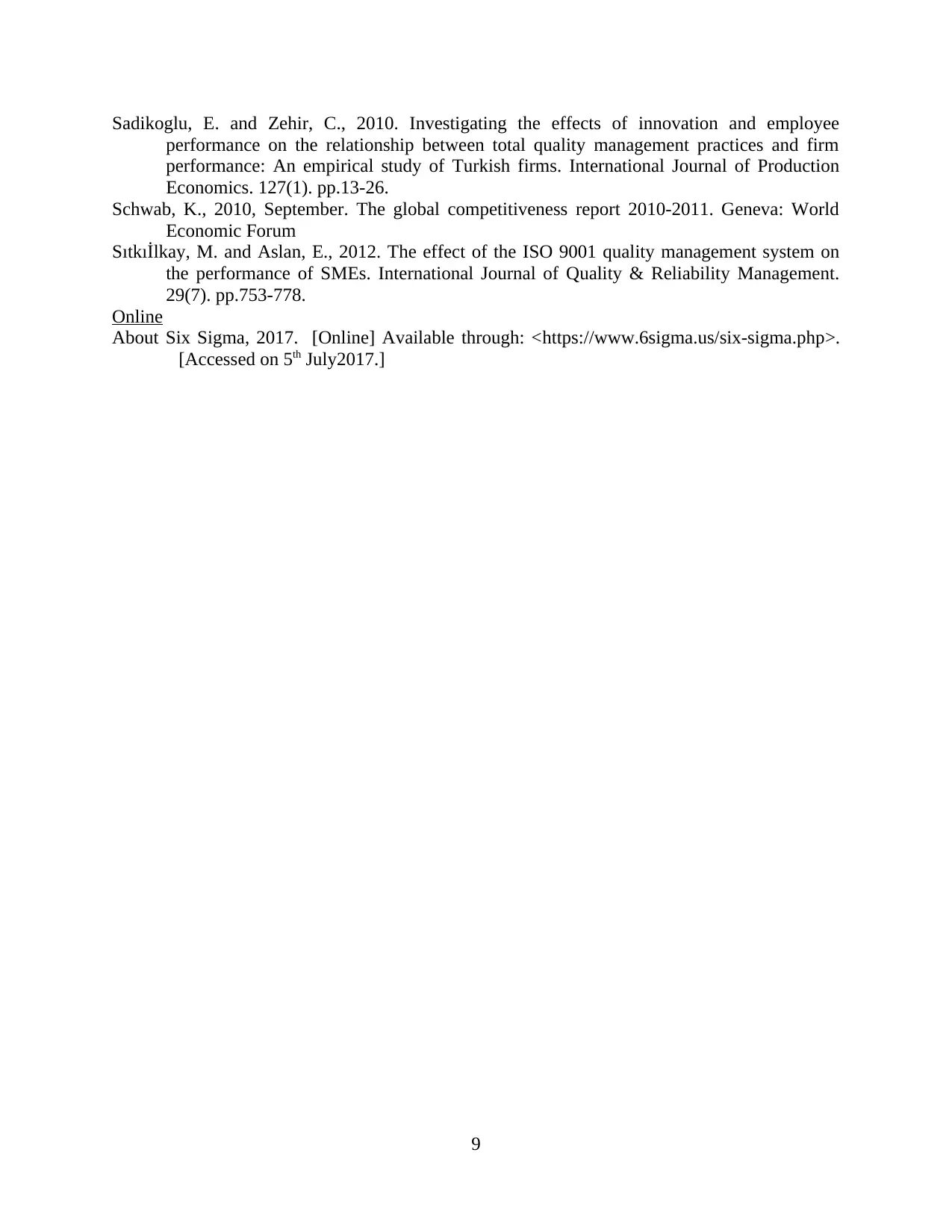
Sadikoglu, E. and Zehir, C., 2010. Investigating the effects of innovation and employee
performance on the relationship between total quality management practices and firm
performance: An empirical study of Turkish firms. International Journal of Production
Economics. 127(1). pp.13-26.
Schwab, K., 2010, September. The global competitiveness report 2010-2011. Geneva: World
Economic Forum
Sıtkıİlkay, M. and Aslan, E., 2012. The effect of the ISO 9001 quality management system on
the performance of SMEs. International Journal of Quality & Reliability Management.
29(7). pp.753-778.
Online
About Six Sigma, 2017. [Online] Available through: <https://www.6sigma.us/six-sigma.php>.
[Accessed on 5th July2017.]
9
performance on the relationship between total quality management practices and firm
performance: An empirical study of Turkish firms. International Journal of Production
Economics. 127(1). pp.13-26.
Schwab, K., 2010, September. The global competitiveness report 2010-2011. Geneva: World
Economic Forum
Sıtkıİlkay, M. and Aslan, E., 2012. The effect of the ISO 9001 quality management system on
the performance of SMEs. International Journal of Quality & Reliability Management.
29(7). pp.753-778.
Online
About Six Sigma, 2017. [Online] Available through: <https://www.6sigma.us/six-sigma.php>.
[Accessed on 5th July2017.]
9
1 out of 11
Related Documents
Your All-in-One AI-Powered Toolkit for Academic Success.
+13062052269
info@desklib.com
Available 24*7 on WhatsApp / Email
![[object Object]](/_next/static/media/star-bottom.7253800d.svg)
Unlock your academic potential
Copyright © 2020–2025 A2Z Services. All Rights Reserved. Developed and managed by ZUCOL.





